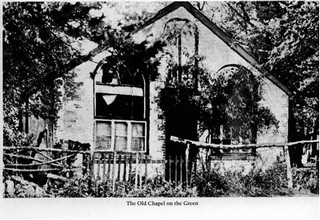Murton Wesleyan Methodist Church

Photo: Geoffrey R. Orrin A History of Bishopston – Gomer Press 1986.
The Old Chapel was modified for occupation by John Vine 1913-1940, prior to being incorporated in The Chestnuts. (Information supplied by Mrs Madge Hooper neé Vine)
The Chapel’s success was short lived. The congregation had dwindled to such an extent that in the spring of 1834 the now deserted chapel was used by the Primitive Methodists for a preaching campaign by the Rev Henry Higginson, ‘The Raving Ranter’. The Wesleyan cause did not revive until the late 1840s, though membership was small and once again the cause collapsed.
With the support of the thriving Wesleyan Methodist cause at Mumbles, the Chapel on the Green re-opened in the late 1870s, a Mumbles local preacher, Mr. Giles Hall, preaching the first sermon there for many years. Another Mumbles member, Mr. Tom Jones, started a Sunday School. From this time on, the Wesleyan cause at Murton prospered, with local preachers enduring many hardships, particularly on winter nights, travelling from Swansea and Mumbles to preach there.
The decision to build a new chapel was taken in 1889, possibly as a result of members having been impressed by the relatively new chapel at Pitton, visited on the occasion of a Sunday School Treat. The new building was not erected on the old site, but on the opposite side of Murton Green, on land leased from Mr. James Webborn, which in 1976 was bequeathed to the Murton Trustees by his direct descendant, Mrs. Catherine Rees, the front garden of whose house had been sacrificed for the building site.
The chapel was built from locally hewn stone, with local labour, the foundation stone being laid on July 6th 1896. The opening ceremony took place on January 14th 1897, the preacher being the Rev. Rawlings of Sketty. So great was the congregation that it took two hours to serve them tea, in relays! The building comprised a porch, chapel and rear schoolroom, which still form the core of the modern chapel, though in the intervening years there have been several additions and modifications.
The first Sunday School Anniversary was held on June 6th 1897, with a Young People’s Service in the afternoon, (solos, recitations, dialogues etc!), and a Cantata performed by the choir, accompanied by a string band, in the evening. Illustrating the close involvement of the Swansea and Gower Circuits in the new chapel, the preacher at the Young People’s Service was Rhossili born Richard Beynon, by this time a pioneer of Brunswick. His brother-in-law, William Richards, had been one of the two stonemasons who built the much-admired Pitton Chapel.
Murton remained part of the Swansea Circuit until 1966, sharing a Minister who was resident in Mumbles. The Gower Circuit had been in the care of a Minister resident at Horton, but after 1966 it also became part of the Swansea Circuit, and from that time Murton has shared a Minister, now resident in Pennard, with the Gower chapels.
The loyalty of the congregation down the years is plain to see – many of the Murton members in 2003 are the direct descendants of those pioneering chapel builders in the 1890s. (J.C.)
Sources:
John C Howells: The History of Murton Methodist Chapel 1896-1996.
Various Gower Records recorded by members of the Glamorgan Family History Society.
